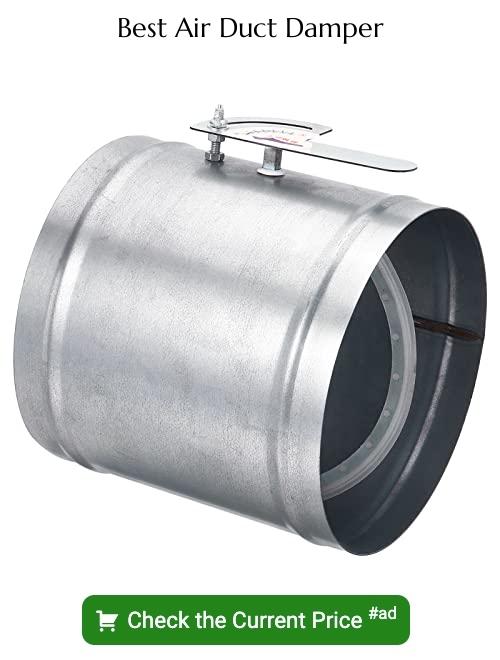Last updated on
Air ducts are a critical part of the equation when it comes to heating and cooling your home. If your air duct damper isn’t working properly, you could be wasting energy and money.
Today’s blog post will show you how to adjust air duct damper units so that you can get the most bang for your buck out of your heating and cooling system.
For an in-depth look at HVAC dampers, be sure to take a look at this post from the team at Anderson Air.
Table of Contents
What Is an Air Duct Damper and What Does It Do?

An air duct damper is a simple but vital component of your HVAC system. It is a movable plate that regulates the flow of air through your ductwork. By opening or closing the damper, you can control how much air flows into each room of your home. This is how you adjust the temperature in each room to make it comfortable.
Dampers are also how you restrict airflow to certain rooms when they are not in use. For example, if you have a guest bedroom that you only use occasionally, you can close the damper to that room to save energy. This ensures that the air in that room stays fresh and prevents drafts from coming into your home.
One thing to keep in mind is that you will need to adjust the dampers regularly to account for changes in temperature and humidity levels.
Overall, an air duct damper is a simple but important way to regulate the temperature in your home and save energy. By understanding how they work, you can learn how to adjust air duct damper units and keep your home comfortable all year round.
How to Adjust a Damper Like a Pro
If you have a manual air duct damper, you may need to adjust it from time to time in order to maintain optimal airflow. The following steps will show you how to do this:
Locate the air duct damper unit — This is typically located near the air handler or furnace.
Identify the adjusting screw or knob on the unit — This will be used to open or close the damper.
Turn the adjusting screw or knob in the desired direction — If you want more airflow, turn it clockwise; if you want less airflow, turn it counterclockwise.
Open or close the damper until it is in the desired position — Be sure not to over-tighten the adjusting screw or knob, as this can damage the unit.
How to Adjust an Automatic Air Duct Damper
The following is a step-by-step guide to adjusting an automatic air duct damper:
Locate the automatic air duct damper — This is usually located near the furnace or air conditioner.
Locate the damper — The damper is typically located near the furnace or air handler.
Adjust the damper handle — The handle is usually located on the top of the damper. Rotating the handle clockwise will open the damper, while rotating it counterclockwise will close it.
Test the airflow — Once you have adjusted the handle, turn on your furnace or air handler and check the airflow through the vents. If necessary, adjust the damper until you achieve the desired airflow.
What Are Some Common Problems with Air Duct Dampers?
Duct dampers are one of the most important components of a forced air heating and cooling system, yet they are often overlooked. Dampers control the flow of air through the ductwork, and they play a vital role in maintaining indoor air quality. Unfortunately, dampers can also be a source of problems.
Here are some of the most common issues:
- Dirty or damaged dampers can cause airflow problems
- Dampers that are not properly calibrated can lead to uneven heating and cooling
- Leaking ductwork can cause damper problems
- Dampers that are not the correct size for the ductwork can cause noise and vibration
If you suspect that your ductwork has a damper problem, it is important to have it inspected by a professional HVAC technician. Only an experienced technician will be able to diagnose and fix the problem correctly.
Other Ways to Improve the Airflow in Your Home
After learning how to adjust damper units, you should continue learning how to optimize the airflow in your home. Here are some tried-and-true techniques you can use to improve the airflow in your home:
- Check your vents and make sure they aren’t blocked by furniture or other objects
- Install a ceiling fan in each room to help circulate the air
- Get an air purifier to remove contaminants from the air
- Change your furnace filter regularly
- Open your windows on days when the weather is nice
- Use exhaust fans in your kitchen and bathroom to remove moisture and odors from the air.
- Invest in a whole-house fan to cool your home without using air conditioning.
- Plant trees and shrubs around your home to provide shade and windbreaks.
- Make sure your attic is well-ventilated to prevent heat buildup in summer months.
- Keep an eye on your utility bills – if you see a sudden increase, it could be a sign that your home needs more ventilation.
The Takeaway
Properly functioning air ducts are key to keeping your home comfortable all year long, so it’s important to make sure the dampers are set correctly. By following the simple instructions in this blog post, you can take care of this task yourself and save money on heating and cooling costs.
You can also contact an HVAC expert to get your air duct damper units adjusted for better airflow and energy efficiency.





